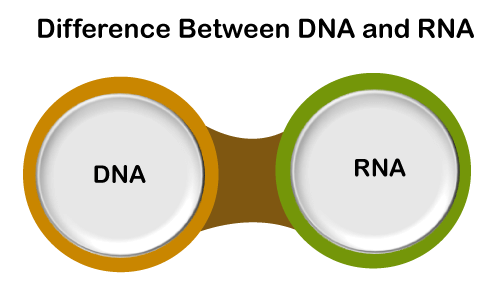Difference between DNA and RNAWe might have studied a lot of things regarding the human system in our science classes. We have studied a lot about the respiratory system, nervous system, white blood cells, red blood cells, etc. There is one more important topic that we have studied during our science lectures, i.e., DNA and RNA. What is DNA and RNA, and how does it helps our body fight several diseases. Well, it is interesting to note that both DNA and RNA are nucleic acids. So, let us discuss each of them in detail. DNA stands for Deoxyribonucleic Acid. DNA consists of a molecular chain. This molecular chain gives general instructions to the body so that the development, growth, and functioning of viruses and organisms occur. 
DNA is one of the major types of a macromolecule. Now, a macromolecule is defined as a large molecule consisting of covalent atoms that are bound together. These macromolecules are very important for all forms of life present on earth. DNA is a double helix consisting of two strands. These two strands are known as polynucleotides. A polynucleotide is considered a biopolymer that comprises more than 13 atomic bonds. A Polynucleotide is a chain-like structure. The nucleotide comprises four nucleobases that are made of nitrogen. These nucleobases are:
Out of these six elements, the DNA can use any four elements to make a nucleobase. These nitrogen-based elements are combined with hydrogen bonds so that DNA is made. DNA is divided into two groups, namely pyrimidines, and purines. Pyridimines consist of two elements, i.e., thymine and cytosine. On the other hand, purines consist of the other two elements, i.e., adenine and guanine. These four elements are considered complementary bonds, while the remaining two elements, i.e., phosphate and deoxyribose, are the primary bonds used as nucleobases. It is interesting to note that the two strands of DNA run parallel to each other. The DNA transforms into long structures in eukaryotic cells. These long structures are known as the Chromosomes. Before the cell division takes place, these chromosomes are replicated. Animals, Plants, and Fungi are eukaryotic organisms. These organisms store their DNA in the cell nucleus and mitochondria. The former is known as Nuclear DNA, while the latter is called Mitochondrial DNA or Chloroplast DNA. On the contrary, bacteria and archaea store their DNA in the cytoplasm. Now, let us look at the chemical modifications of DNA. DNA is packed in chromosomes that are capable of influencing the genes. This structure is called chromatin. There are high levels of methyl and cytosine when there is no gene modification. The vertebrates have higher methyl and cytosine levels while Caenorhabditis Elegans, a worm-like structure lack in such elements. How can DNA be damaged? Well, it is possible to damage DNA, and mutagens can only do this. Mutagen is considered as a physical agent that is capable of changing the genetic material. Mutagen is capable of changing the DNA sequence. Mutagens comprises oxidizing agents, electromagnetic forces, alkylating agents, UV rays, etc. any of the forces mentioned above can damage DNA. Here is an interesting fact to know, i.e., a human cell comprises 1,50,000 bases that undergo damage. The most dangerous form of damage happens in DNA, wherein the cells cannot repair themselves. There are chromosomal translocations that occur in the system. These mutations in the system can cause cancer. The damage in DNA that normally occurs can also cause cancer. If people live long enough with the naturally damaged DNA, they will automatically develop cancer. There is no cure for DNA damage as of now. Well, certain medications are prescribed by doctors that will help in lowering the levels of this damage. Now, let us discuss the RNA. RNA stands for Ribonucleic Acid. RNA is a polymeric molecule that plays a lot of roles. RNA molecules are responsible for the coding, decoding, and regulating the genes. Just like DNA, RNA is also a nucleic acid. RNA also has a chain-like structure, but it comprises only one strand, unlike DNA. The cellular organisms convey the genetic information through the messenger RNA, which is commonly known as mRNA. RNA plays various roles in the human body, like controlling gene expression, mobilize biological reactions, and responding to cellular signals. RNA uses a universal process so that the synthesis of proteins takes place. This process is known as protein synthesis. Well, there are four kinds of RNA. Let us have a look at them.
So, these are the four kinds of RNA that perform several functions in the human body. Now, let us look at some of the important differences between DNA and RNA.
These are the major differences between DNA and RNA. Both DNA and RNA are important for cellular organisms as they perform various functions. They also help in preventing the body from various viruses. Both are responsible for mobilizing the body. Thus, both DNA and RNA are responsible for regulating the body and fighting several diseases.
Next TopicDifference between
|
 For Videos Join Our Youtube Channel: Join Now
For Videos Join Our Youtube Channel: Join Now
Feedback
- Send your Feedback to [email protected]
Help Others, Please Share










